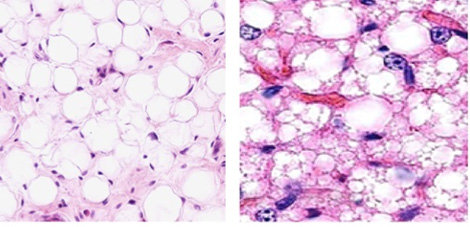|
Specialized Connective Tissues
Recall that cartilage, tendons, ligaments, bone, and blood are
all considered specialized connective tissues. These will be
described in later modules. Here we will look at both white and
brown adipose tissue as specialized CTs.
Adipose tissue
Connective tissue in which fat storing cells or adipocytes
predominate is called adipose tissue. Due to extraction of the
lipids in these cells in most H&E stained paraffin preparations, you
will notice a lack of stain where lipid droplets were once stored.
White adipose tissue: This tissue is primarily made up of
white or unilocular adipocytes, which are so named because they have
a single large droplet of lipid that almost entirely fills the cell.
The lipid droplet displaces the flattened nucleus and organelles to
the periphery. This tissue plays a key role in energy storage,
insulation (prevents heat loss), and cushioning of vital organs. It
also produces hormones, growth factors, and inflammatory mediators
and is now considered a key endocrine organ that regulates
nutritional homeostasis. Examine
example 1 and
example 2.
Brown adipose tissue: In humans, this tissue is found
principally in newborns and comprises 2 to 5% of adipose tissue on
the back, neck, and shoulders, where it plays a crucial role in
thermogenesis. Brown adipose tissue is composed of smaller
multilocular adipocytes, which are so named because they have many
lipid droplets. They also contain numerous mitochondria that give
the unstained tissue a brown color. Nuclei tend to be more centrally
located and spherical. The small amount of brown fat in adults is
found in adipose tissue around the kidneys, adrenals, aorta, and
mediastinum.
Compare the differences between white (left image) and brown (right
image) adipose tissue.

Now let's examine the
cells that are associated with CT. |